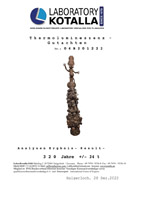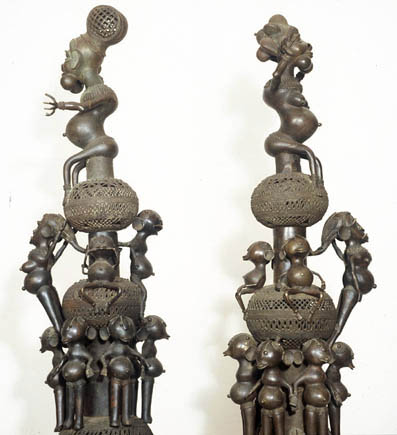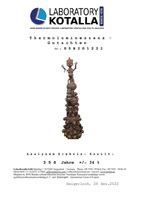Galerie Peter Herrmann |
- | Ancient Art from Africa |
||
 |
Foto: Peter Herrmann |
| Thermoluminescence - Expertises | Dynasty Pillars |
 |
from Sultan's Palace |
|
| edited in the internet since 1996 |
| Explication |
| Translated with www.DeepL.com/Translator (free version) The figures mounted in a circle around the 230 cm high columns represent the traditional hierarchical order of the social community of the Bamoun people from Cameroon. The representation starts from the bottom with heads, which become fewer and fewer towards the top. They probably represent the ancestors on whose "war and being" the dynasty is based. A single male figure that can be seen at the female-crowned column in the base is probably to be interpreted as the mediator to the ancestral world. Four circles on one column and five on the other depict strangely elaborated, mostly androgynous beings. In the lower area, despite a static order, the figures are individualised and all gesticulate. They are not holding hands, like the figures one row up. There, the posture is calm, but the mouths are open, as in conversation or communal singing. |
 |
One row higher again, the figures are shown closed in a circle and silent. Different stages of discipline are thus shown here. Both columns are crowned by a male and a female figure. These are the king elected by the council on the one hand and the queen mother, who is just as important in terms of social position. Both are depicted with the distended cheeks of the heralds. These cheeks have become iconographically established among the Bamoun as a sign of dignity and importance and are still used today as a means of expression. Similar to a caryatid, the upper ruler figure is supported and protected by a person who is conspicuously larger than other figures. In both groupings, this is the gender counterpart. A gender neutrality as in the lower figures is abolished at the top. |
| The circle below the two ruler figures contains references to the succession to the throne. Below the queen mother are three similar figures, recognisable as children in size and gesture. On top of the male column, behind the king's back, is a figure that is again larger than the other two and male. |
 |
Overall, the arrangement from bottom to top invites two complementary interpretations. Traditional social hierarchy and human stages of ageing, which the caster united in a highly condensed allegorical dimension and in a sophisticated aesthetic. This combination makes the two dynasty columns the most sensational objects of African foundry art. The production of these pillars took place in pre-Islamic times. However, the motifs were adopted into modern times. The figurative depiction of the Bamoun survived the liberal Islamisation that was mainly led by King Njoya around 1910. The matriarchal influence dominant in these representations was probably also important for the interpretation of Islam, which strongly distinguishes sub-Saharan Africa from North Africa.
|
| Exhibitions |
| .flex_re-flex.impact | |
| 200 Jahre Metallkunst aus Afrika. Stuttgart 2000 | |
| 200 Jahre Metallkunst aus Afrika. Berlin 2001 |
